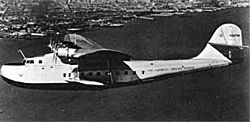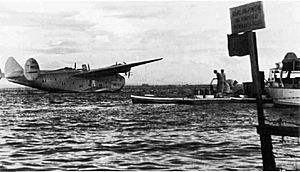China Clipper flight departure site facts for kids
Quick facts for kids Site of the China Clipper flight departure |
|
|---|---|

Martin model 130 China Clipper class flying boat.
|
|
| Location | Alameda Naval Air Station, Alameda, California |
| Designated | November 5, 1985 |
| Reference no. | 968 |
| Lua error in Module:Location_map at line 420: attempt to index field 'wikibase' (a nil value). | |
The China Clipper flight departure site is a special place in California. It's recognized as California Historical Landmark number 968. This is where Pan American World Airways (Pan Am) started its amazing airmail service across the Pacific Ocean.
On November 22, 1935, a famous flying boat called the China Clipper took off from here. This first flight was so exciting that all the other flying boats on this route became known as China Clippers. For a while, this new mail service captured everyone's imagination. It was like the old Pony Express, but in the sky! It also offered fast, fancy travel, much like the Concorde did years later.
Contents
Where the China Clipper Started
This historic site is located in Alameda, California. Back in 1927, some wetlands near San Francisco Bay were filled in. This created an airport with runways, hangars, and a special harbor for boats.
By 1930, the United States Army Air Corps was using the site, calling it Benton Field. Pan Am started using the harbor here in 1935 for their flights across the Pacific. Later, in 1936, the city of Alameda gave the airport to the U.S. government.
The United States Navy then took over, turning it into a naval air station by 1940. Pan Am moved its main terminal to Treasure Island for a while. But after the Navy took over Treasure Island, Pan Am's flying boats continued to use Navy facilities for their flights. Today, this site is part of the Alameda Naval Air Station.
Flying in Peacetime
The first flight of the China Clipper carried only mail. But by October 1936, passengers could also fly! Pan Am used three Martin M-130 flying boats for these trips. They were named Hawaii Clipper, Philippine Clipper, and China Clipper.
The journey from San Francisco Bay was long. It stopped at places like Pearl Harbor, Midway Atoll, Wake Island, and Guam before reaching Manila Bay. The whole trip took about six days, with around 60 hours of flying time. The planes flew at about 130 miles per hour.
Each flying boat was very spacious. It could carry about a dozen passengers. There were usually two crews on board. The second crew learned from the first crew how to navigate and fly over the ocean. A one-way ticket cost about $700, which was a lot of money back then!
Sadly, some of these early flights faced problems. Ed Musick, the pilot of the first airmail flight, died in 1938 when another flying boat, the Samoan Clipper, exploded. The Hawaii Clipper disappeared in 1938 while flying from Guam to Manila. The reasons for its disappearance were unclear. Interestingly, Fred Noonan, who was the navigator on the first China Clipper flight, also disappeared a year earlier with Amelia Earhart.
In 1939, newer Boeing 314 flying boats joined the fleet, like the Honolulu Clipper and California Clipper. By 1941, other Clippers like the Pacific Clipper and Anzac Clipper started flying to New Zealand and Australia.
Clippers During Wartime
When Pearl Harbor was attacked in December 1941, the Philippine Clipper was near Wake Island. It was shot at by Japanese planes while floating on the lagoon. Even with 96 bullet holes, the brave Clipper managed to fly all the way back to California!
Another plane, the Pacific Clipper, was in Auckland, New Zealand during the attack. Its crew decided to fly west, all the way around the world, to get back to the United States. In January 1942, it arrived in New York. This was the first time a commercial aircraft had flown around the entire globe!
In 1942, the United States Navy took control of the Clippers. Pan Am crews still flew them, but they were now helping with the war effort. Clippers flew between California and Hawaii, and to Australia, stopping at places like Canton Island, Fiji, and New Zealand. This was important when Japan controlled the Western Pacific.
Sometimes, if the weather was bad in San Francisco Bay, Clippers would land at Clear Lake Outlying Field. In January 1943, the Philippine Clipper crashed during a storm in California. It was carrying Robert Henry English, a Navy commander, and his team. Search crews took over a week to find the crash site.
The China Clipper, the last of the original three Martin M-130s, crashed in Trinidad in January 1945. The Honolulu Clipper, one of the Boeing 314s, was still flying for the Navy in November 1945. It had to land in the ocean after two engines failed. Navy mechanics tried to fix it at sea, but couldn't. The Honolulu Clipper was damaged in a collision with a Navy ship and had to be sunk because it couldn't be saved.
The End of an Era
After World War II, the remaining Clippers went back to civilian owners. However, the time of the large commercial flying boat was coming to an end. During the war, many huge runways had been built around the world for heavy bombers. Military bomber technology was quickly changed for commercial airlines. These new planes could land on solid ground, which was much easier and safer than landing on water.


